Future Changes of Snow in Alaska and the Arctic under Stabilized Global Warming Scenarios
Abstract
:1. Introduction
2. Data and Methods
3. Results and Discussion
3.1. Historical Trends
3.2. Future Projections
4. Conclusions
- The pattern of recent temperature change in the Arctic is consistent with the greenhouse-gas-driven warming projected for the future by the HAPPI ensemble of high-resolution climate model simulations;
- The approximate threshold of global warming for a statistically significant increase in temperature over 50% of the pan-Arctic land area is 1.5 °C. The corresponding threshold for precipitation is approximately 2.0 °C;
- The response of Eurasian snow cover also shows an east–west dipole rather than the north–south dipole found over Alaska. The orientation of the dipole in both cases is consistent with the direction of the climatological temperature gradient;
- The amount of global warming strongly affects the change in winter snowfall over Alaska. Changes are near zero (+/−10%) and generally insignificant for 1.5 °C global warming. For global warming of 2 °C or more, winter snow accumulation increases over most of Alaska, but decreases in Southwest and Southeast Alaska. The areas of significant change increase from less than 10% of the state under 1.5 °C global warming to more than half the state under 3.0 °C global warming;
- The high-resolution output shows that actual changes in winter snowfall in Alaska are larger over mountains (e.g., Alaska Range and Brooks Range) than surrounding low-elevation areas;
- The across-ensemble spread of winter snowfall over Alaska is large and comparable with the change from 1997–2005 to 2107–2115.
Author Contributions
Funding
Institutional Review Board Statement
Informed Consent Statement
Data Availability Statement
Acknowledgments
Conflicts of Interest
References
- Callaghan, T.V.; Johansson, M.; Brown, R.D.; Groisman, P.Y.; Labra, N.; Radionov, V. Changing Snow Cover and Its Impacts. In Snow, Water, Ice and Permafrost in the Arctic (SWIPA): Climate Change and the Cryosphere; Arctic Monitoring and Assessment Programme: Oslo, Norway, 2011; p. 58, Chapter 4; ISBN 978-82-7971-071-4. [Google Scholar]
- Klein, D.; Walsh, J.E.; Shulski, M. What killed the reindeer of St. Matthew Island? Weatherwise 2009, 62, 32–39. [Google Scholar] [CrossRef]
- Schmidt, N.M.; Reneerkens, J.; Christensen, J.H.; Olesen, M.; Roslin, T. An ecosystem-wide reproductive failure with more snow in the Arctic. PLoS Biol. 2019, 17, e3000392. [Google Scholar] [CrossRef] [Green Version]
- He, H.; Yang, D.; Behrangi, A.; Stuefer, S.L.; Pan, X.; Mekis, F.; Dibike, Y.; Walsh, J.E. Precipitation Characteristics and Changes. In Arctic Hydrology, Permafrost and Ecosystems; Yang, D., Kane, D.L., Eds.; Springer: Berlin/Heidelberg, Germany, 2020; pp. 25–59. [Google Scholar] [CrossRef]
- Mudryk, L.; Brown, R.; Derksen, C.; Luojus, K.; Decharme, B. Terrestrial snow cover. In State of the Climate in 2018. Bull. Amer. Meteor. Soc. 2019, 100, S160–S161. [Google Scholar] [CrossRef]
- Brown, R.; Schuler, D.V.; Bulygina, O.; Derksen, C.; Luojus, K.; Mudryk, L.; Wang, L.; Yang, D. Arctic Terrestrial Snow Cover. In Snow, Water, Ice and Permafrost in the Arctic (SWIPA) 2017; Arctic Monitoring and Assessment Programme (AMAP): Oslo, Norway, 2017; Chapter 3; pp. 25–64. [Google Scholar]
- Mudryk, L.; Santolaria-Otín, M.; Krinner, G.; Ménégoz, M.; Derksen, C.; Brutel-Vuilmet, C.; Brady, M.; Essery, R. Historical Northern Hemisphere snow cover trends and projected changes in the CMIP6 multi-model ensemble. Cryosphere 2020, 14, 2495–2514. [Google Scholar] [CrossRef]
- Mudryk, L.; Elias Chereque, A.; Brown, R.; Derksen, C.; Loujus, K.; Decharme, B. Terrestrial Snow Cover. In NOAA Arctic Report Card 2020; Thoman, R.L., Richter-Menge, J., Druckenmiller, M.L., Eds.; National Oceanic and Atmospheric Admstration: Silver Spring, MD, USA, 2020. [Google Scholar] [CrossRef]
- Zhu, X.; Lee, S.-Y.; Wen, X.; Wei, Z.; Ji, Z.; Zheng, Z.; Dong, W. Historical evolution and future trend of Northern Hemisphere snow cover in CMIP5 and CMIP6 models. Environ. Res. Lett. 2021, 16, 065013. [Google Scholar] [CrossRef]
- Liu, J.; Curry, J.A.; Wang, H.; Song, M.; Horton, R.M. Impact of declining Arctic sea ice on winter snowfall. Proc. Nat. Acad. Sci. USA 2012, 190, 4074–4079. [Google Scholar] [CrossRef] [Green Version]
- McCrystal, M.R.; Stroeve, J.; Serreze, M.; Forbes, B.C.; Screen, J.A. New climate models reveal faster and larger increases in Arctic precipitation than previously projected. Nat. Commun. 2021, 12, 6765. [Google Scholar] [CrossRef]
- Bintanja, R.; Andry, O. Towards a rain-dominated Arctic. Nat. Clim. Change 2017, 7, 263–267. [Google Scholar] [CrossRef]
- Bintanja, R.; Selten, F.M. Future increases in Arctic precipitation linked to local evaporation and sea ice retreat. Nature 2014, 509, 479–482. [Google Scholar] [CrossRef] [PubMed]
- Bachand, C.L.; Walsh, J.E. Extreme precipitation events in Alaska: Historical trends and projected changes. Atmosphere 2022, 13, 388. [Google Scholar] [CrossRef]
- O’Gorman, P.A. Contrasting responses of mean and extreme snowfall to climate change. Nature 2014, 512, 416–418. [Google Scholar] [CrossRef] [PubMed] [Green Version]
- Hersbach, H.; Bell, B.; Berrisford, P.; Hirahara, S.; Horányi, A.; Muñoz-Sabater, J.; Nicolas, J.; Peubey, C.; Radu, R.; Schepers, D.; et al. The ERA5 global reanalysis. Q. J. R. Meteor. Soc. 2020, 146, 1999–2049. [Google Scholar] [CrossRef]
- Graham, R.M.; Hudson, S.R.; Matarilli, M. Improved performance of ERA5 in Arctic gateway relative to four global atmospheric reanalyses. Geophys. Res. Lett. 2019, 46, 6138–6147. [Google Scholar] [CrossRef] [Green Version]
- Wang, C.; Graham, R.M.; Wang, K.; Gerland, S.; Granskig, M.A. Comparison of ERA5 and ERA-Interim near-surface air temperature, snowfall and precipitation over Arctic sea ice: Effects on sea ice thermodynamics and evolution. Cryosphere 2019, 21, 1661–1679. [Google Scholar] [CrossRef] [Green Version]
- Crosett, C.C.; Betts, A.K.; Dupigny, L.-A.L.; Bomblies, A. Evaluation of daily precipitation from the ERA5 global reanalysis against GHCN observations in the northeastern United States. Climate 2020, 8, 148. [Google Scholar] [CrossRef]
- Avila-Diaz, A.; Bromwich, D.H.; Wilson, A.B.; Justino, F.; Wang, S.-H. Climatic extremes over the North American Arctic in modern reanalyses. J. Clim. 2021, 34, 2385–2410. [Google Scholar] [CrossRef]
- Mitchell, D.; AchutaRao, K.; Allen, M.; Bethke, I.; Beyerle, U.; Ciavarella, A.; Forster, P.M.; Fuglestvedt, J.; Gillett, N.; Haustein, K.; et al. Half a degree additional warming, prognosis and practical impacts. Geosci. Model Dev. 2017, 10, 571–583. [Google Scholar] [CrossRef] [Green Version]
- IPCC. Climate Change 2021: The Physical Science Basis. Contribution of Working Group I to the Sixth Assessment Report of the Intergovernmental Panel on Climate Change; Masson-Delmotte, V., Zhai, P., Pirani, A., Connors, S.L., Péan, C., Berger, S., Caud, N., Chen, Y., Goldfarb, L., Gomis, M.I., et al., Eds.; Intergovernmental Panel on Climate Change, Cambridge University Press: Cambridge, UK, 2021; Available online: https://www.ipcc.ch/report/sixth-assessment-report-working-group-i/ (accessed on 20 March 2022).
- Wehner, M.F.; Reed, K.A.; Li, F.; Prabbat; Bacmeister, J.; Chen, C.-T.; Paciorek, C.; Gleckler, P.J.; Sperber, K.R.; Collins, W.D.; et al. The effect of horizontal resolution in simulation quality in the Community Atmospheric Model, CAM5.1. J. Adv. Model. Earth Syst. 2014, 6, 980–997. [Google Scholar] [CrossRef]
- Bacmeister, J.; Wehner, M.F.; Neale, R.B.; Gettelman, A.; Hannay, C.; Lauritzen, P.H.; Caron, J.M.; Truesdale, J.E. Exploratory high-resolution climate simulations using the Community Atmosphere Model (CAM). J. Clim. 2014, 27, 3073–3099. [Google Scholar] [CrossRef]
- Wehner, M.; Lee, J.; Risser, M.; Ullrich, P.; Gleckler, P.; Collins, W.D. Evaluation of extreme sub-daily precipitation in high-resolution global climate model simulations. Phil. Trans. R. Soc. A 2021, 379, 20190545. [Google Scholar] [CrossRef] [PubMed]
- Chen, D.; Dai, A. Precipitation characteristics in the Community Atmosphere Model and their dependence on model physics and resolution. J. Adv. Model. Earth Sys. 2019, 11, 2352–2374. [Google Scholar] [CrossRef] [Green Version]
- Stone, D.A.; Christidis, N.; Folland, C.; Perkins-Kirkpatrick, S.; Perlwitz, J.; Shiogama, H.; Wehner, M.F.; Wolski, P.; Cholia, S.; Krishnan, H.; et al. Experiment design of the international CLIVAR C20C+ detection and attribution project. Weather Clim. Extrem. 2019, 24, 100206. [Google Scholar] [CrossRef]
- AMAP. Arctic Climate Change Update 2021: Key Trends and Impacts. Summary for Policy-Makers; Arctic Monitoring and Assessment Programme (AMAP): Tromsø, Norway, 2021; p. 16. Available online: https://www.amap.no/documents/doc/arctic-climate-change-update-2021-key-trends-and-impacts.-summary-for-policy-makers/350 (accessed on 20 March 2022).
- Perovich, D.K.; Richter-Menge, J.A. Loss of sea ice in the Arctic. Ann. Rev. Mar. Sci. 2009, 1, 417–441. [Google Scholar] [CrossRef] [PubMed] [Green Version]
- Stroeve, J.; Serreze, M.; Drobot, S.; Gearheard, S.; Holland, M.; Maslanik, J.; Meier, W.; Scambos, T. Arctic sea ice plummets in 2007. Eos Trans. AGU 2008, 89, 13–14. [Google Scholar] [CrossRef]
- Serreze, M.C.; Barry, R.G. The Arctic Climate System; Cambridge University Press: Cambridge, UK, 2014; p. 404. ISBN 978110703717. [Google Scholar]
- Landrum, L.; Holland, M.M. The emergence of a New Arctic: When extremes become routine. Nat. Clim. Change 2020, 10, 1108–1115. [Google Scholar] [CrossRef]
- Bieniek, P.A.; Bhatt, U.S.; Walsh, J.E.; Rupp, T.S.; Zhang, J.; Krieger, J. Dynamical downscaling of ERA-Interim temperature and precipitation for Alaska. J. Appl. Meteor. Climatol. 2016, 55, 635–654. [Google Scholar] [CrossRef]
- Cassano, J.J.; Uotila, P.; Lynch, A.H.; Cassano, E.N. Predicted changes in synoptic forcing of net precipitation in large Arctic river basins during the 21st century. J. Geophys. Res. 2007, 112, G04549. [Google Scholar] [CrossRef] [Green Version]
- Lader, R.; Walsh, J.E.; Bhatt, U.S.; Bieniek, P.A. Anticipated changes to the snow season in Alaska: Elevation dependency, timing and extremes. Int. J. Climatol. 2019, 40, 169–187. [Google Scholar] [CrossRef]
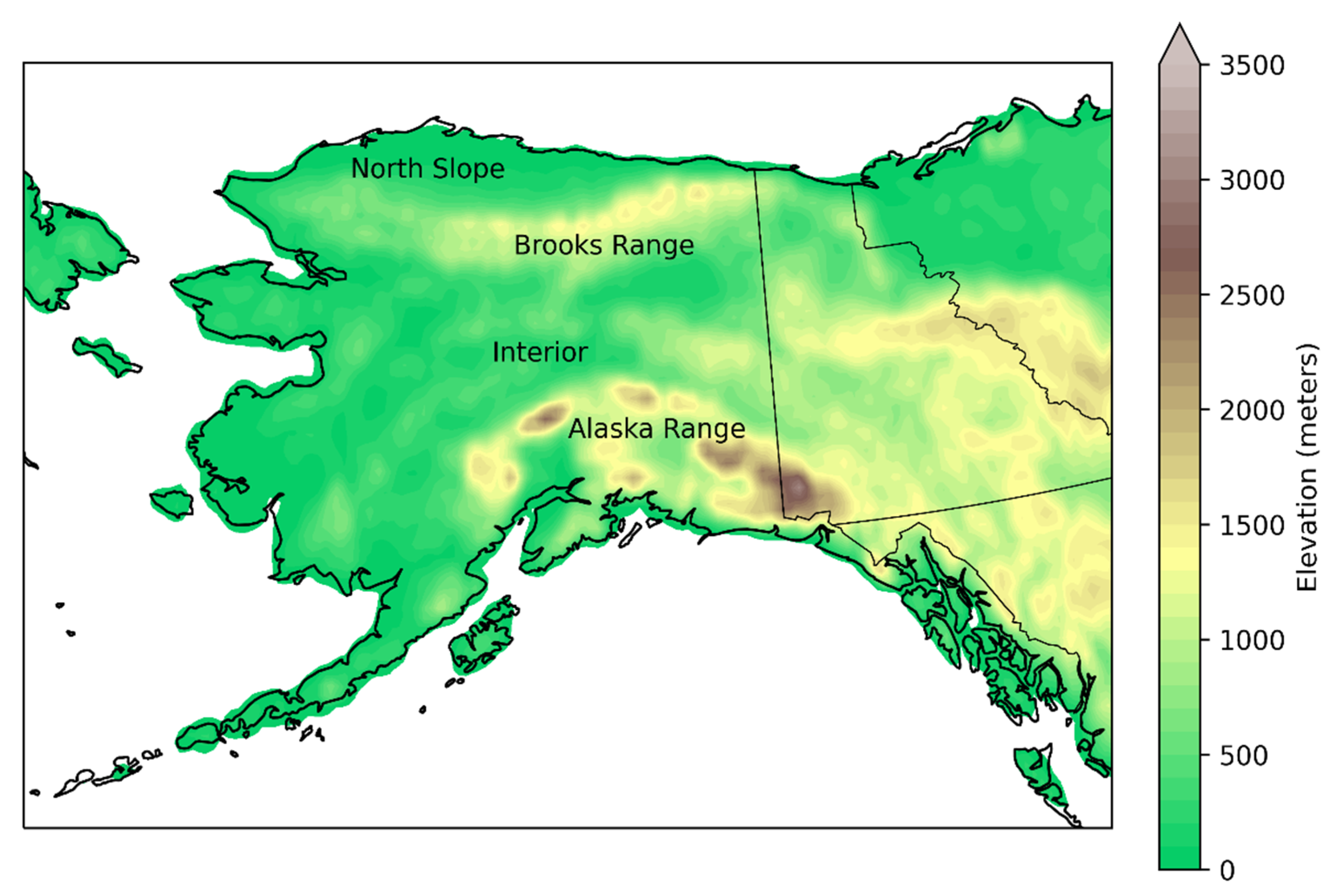
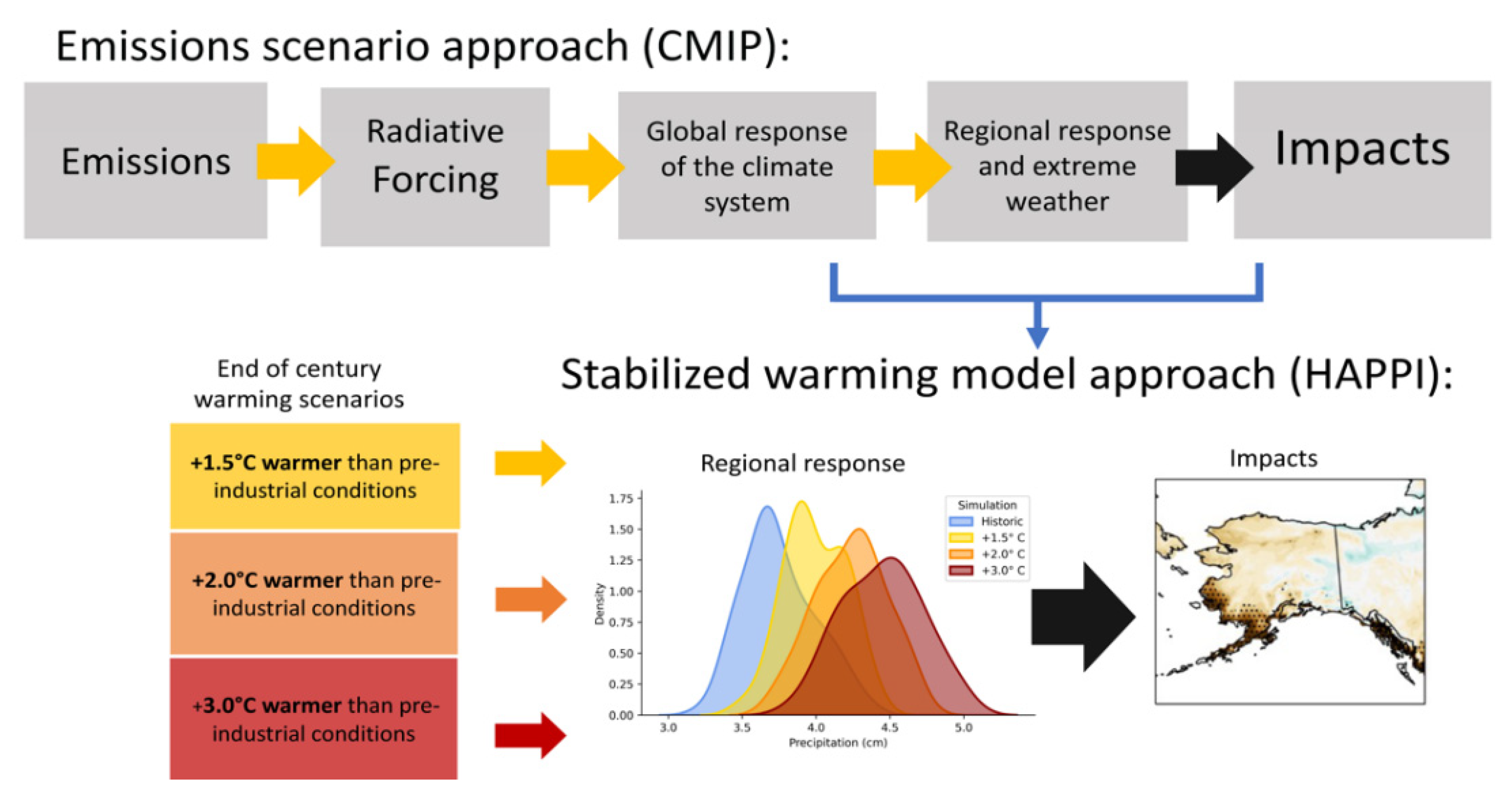
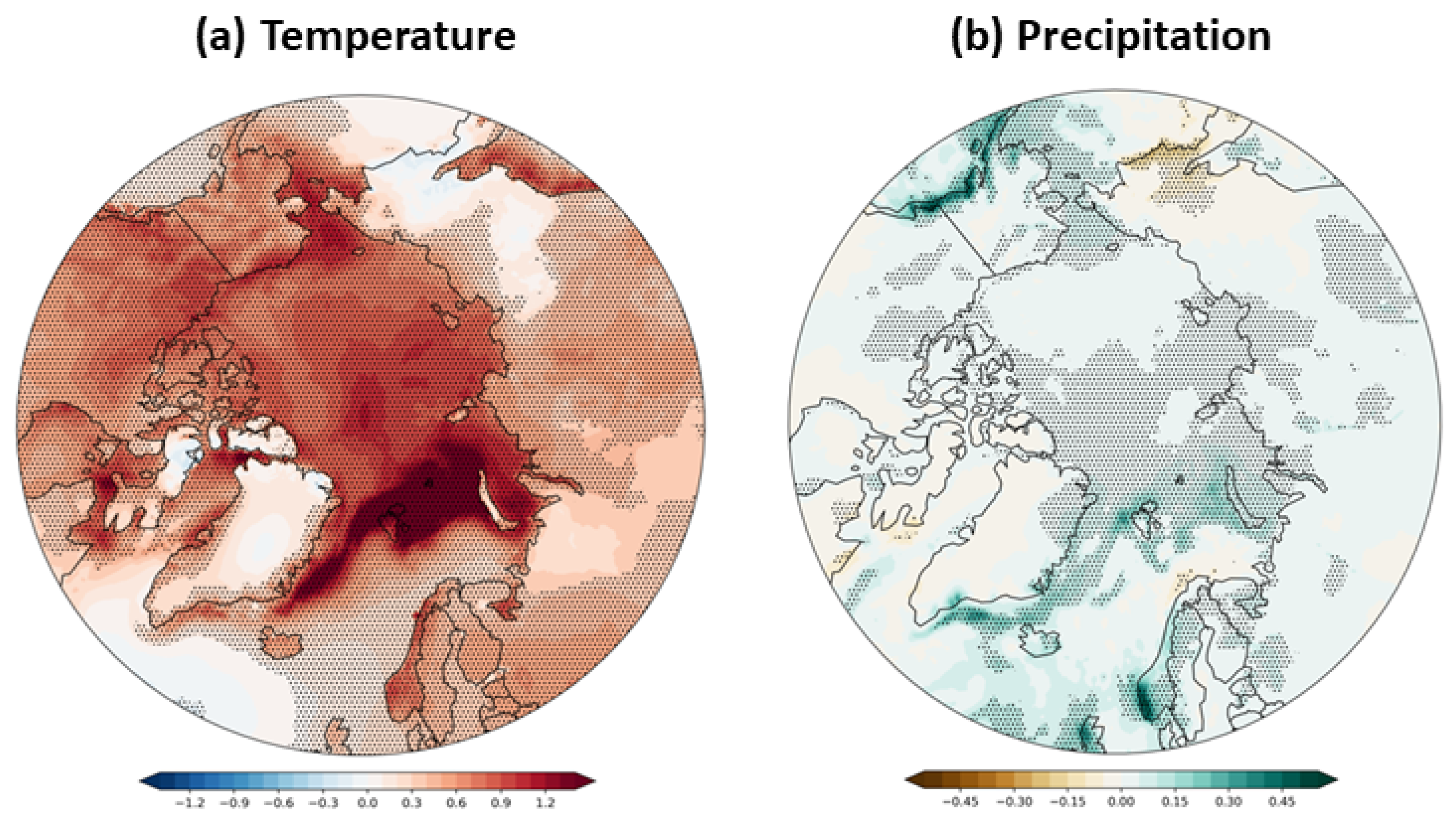
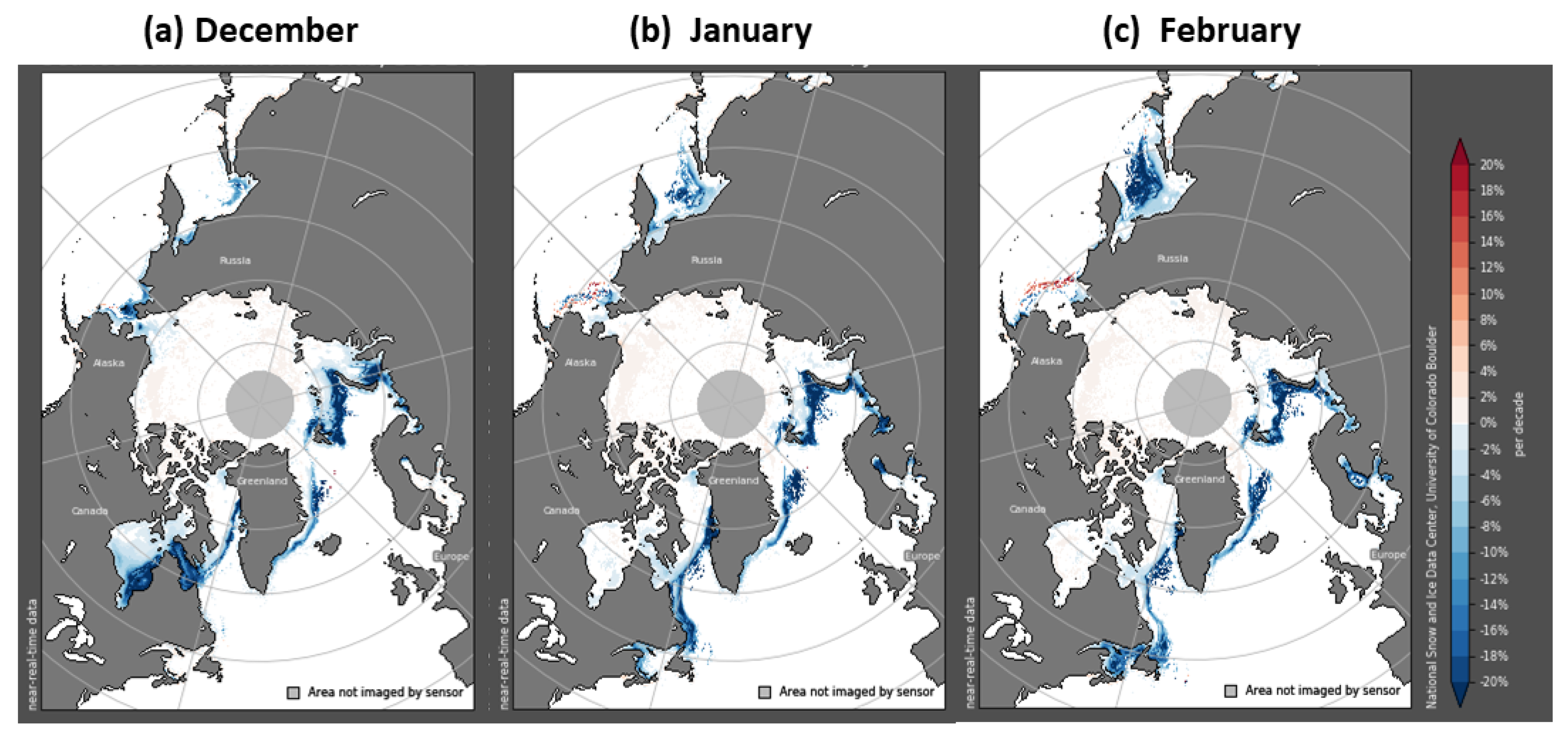
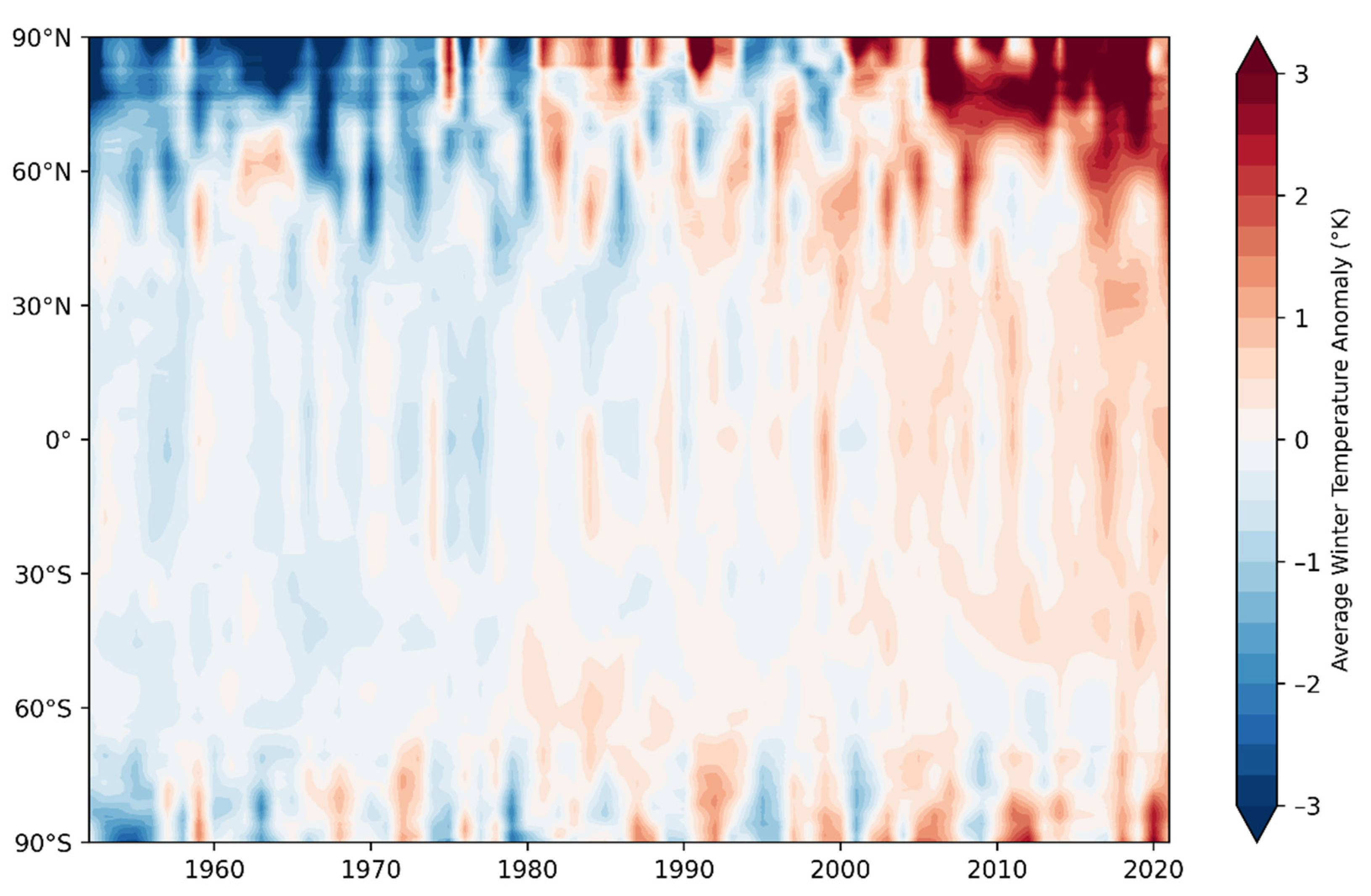
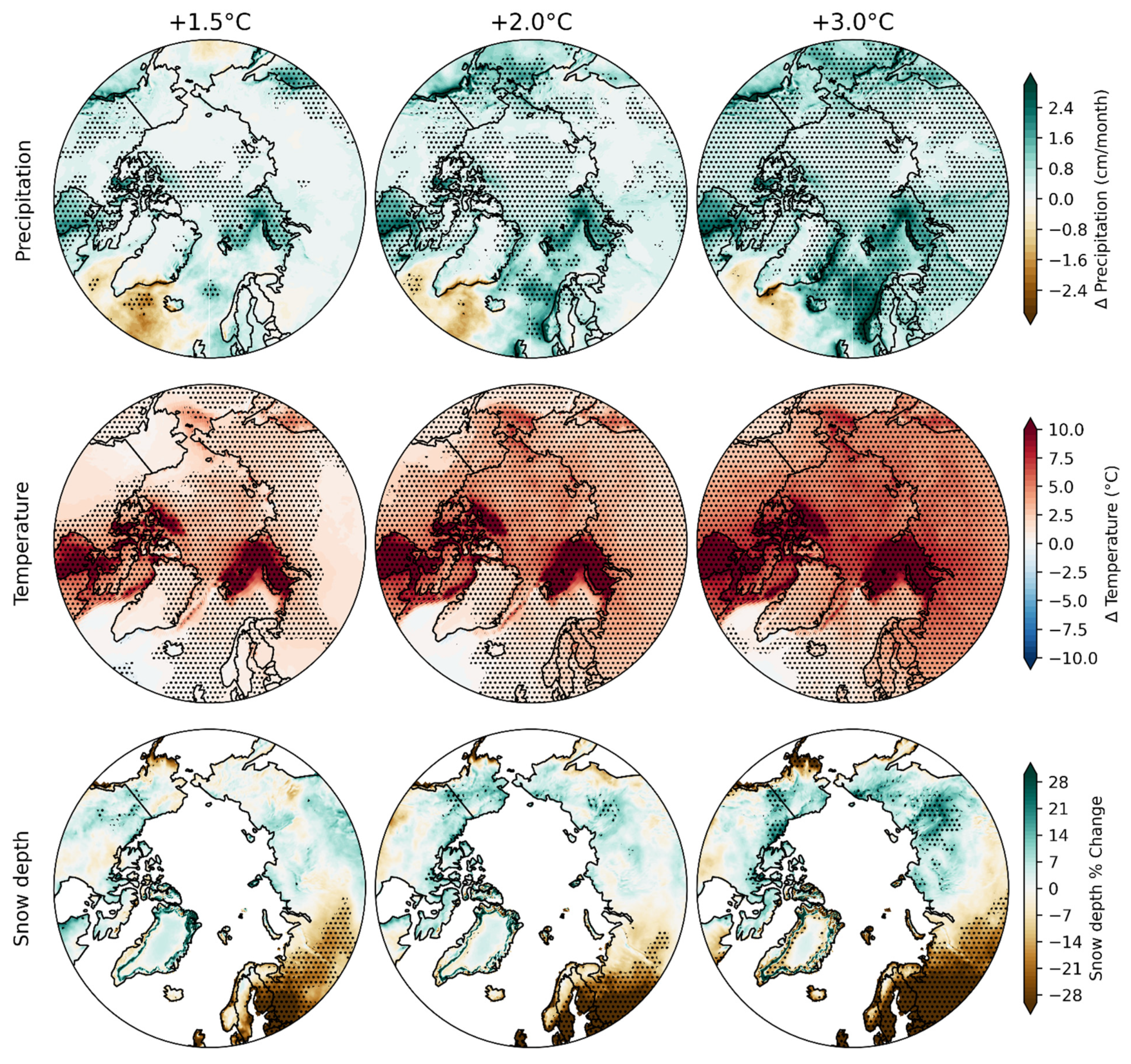
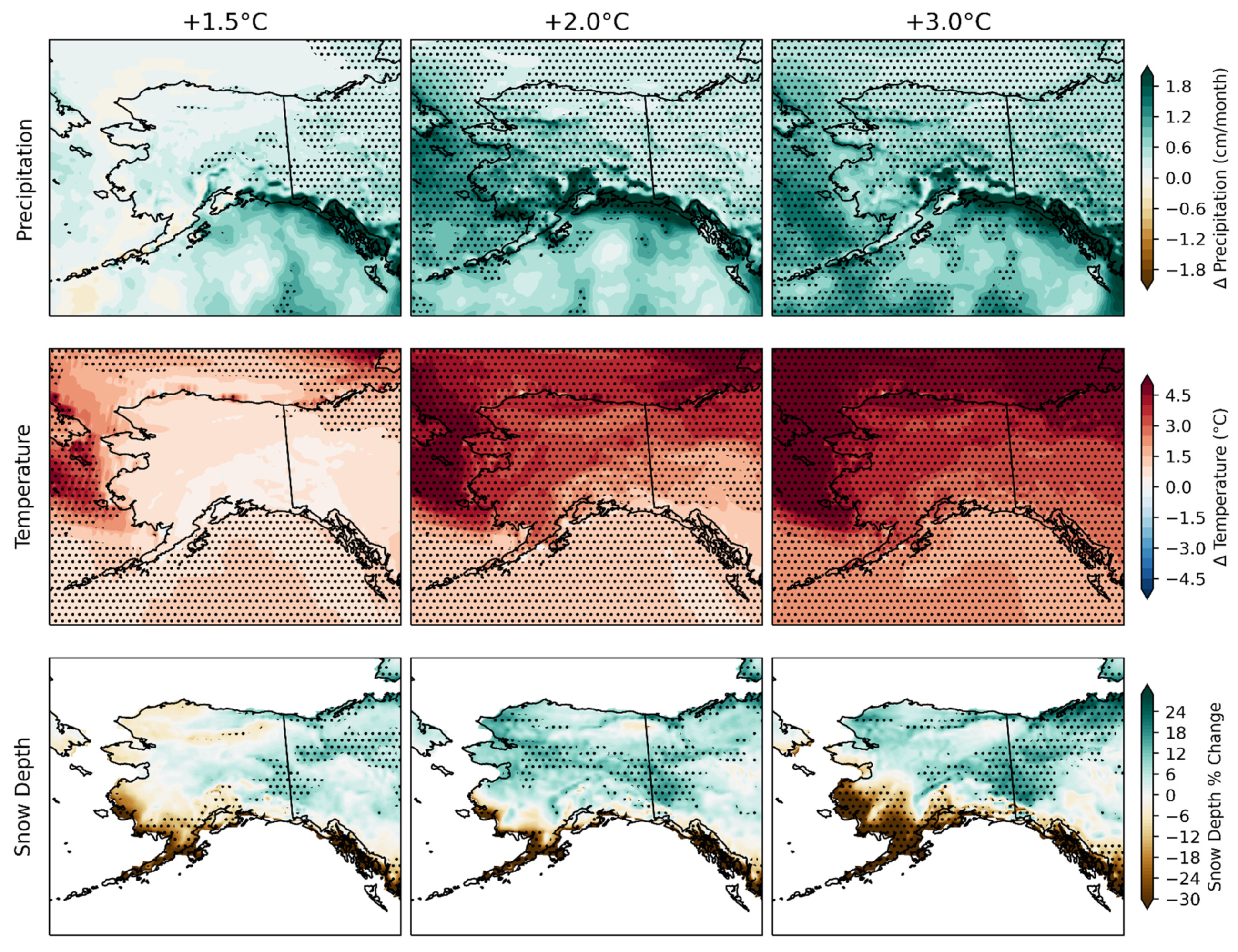
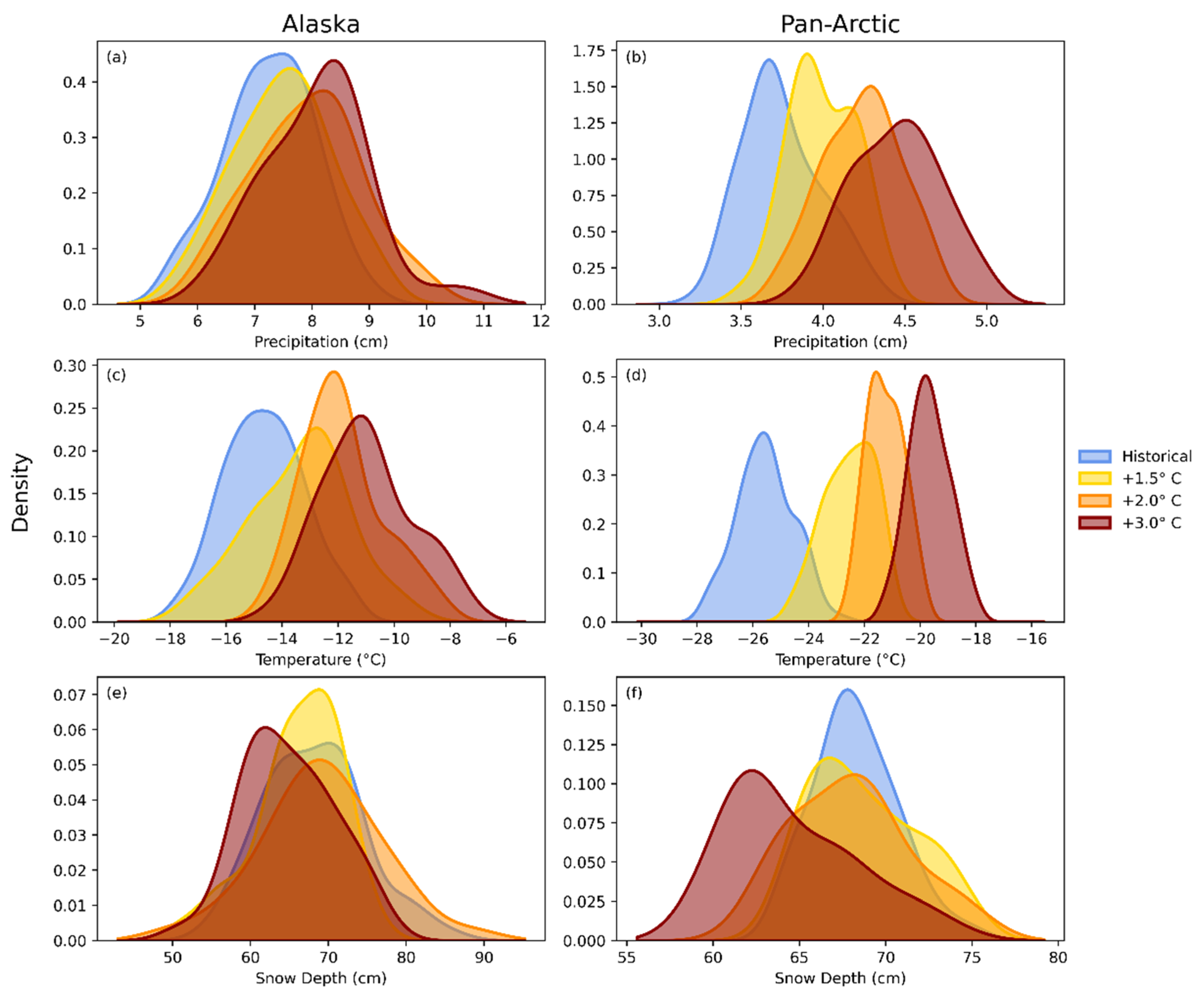
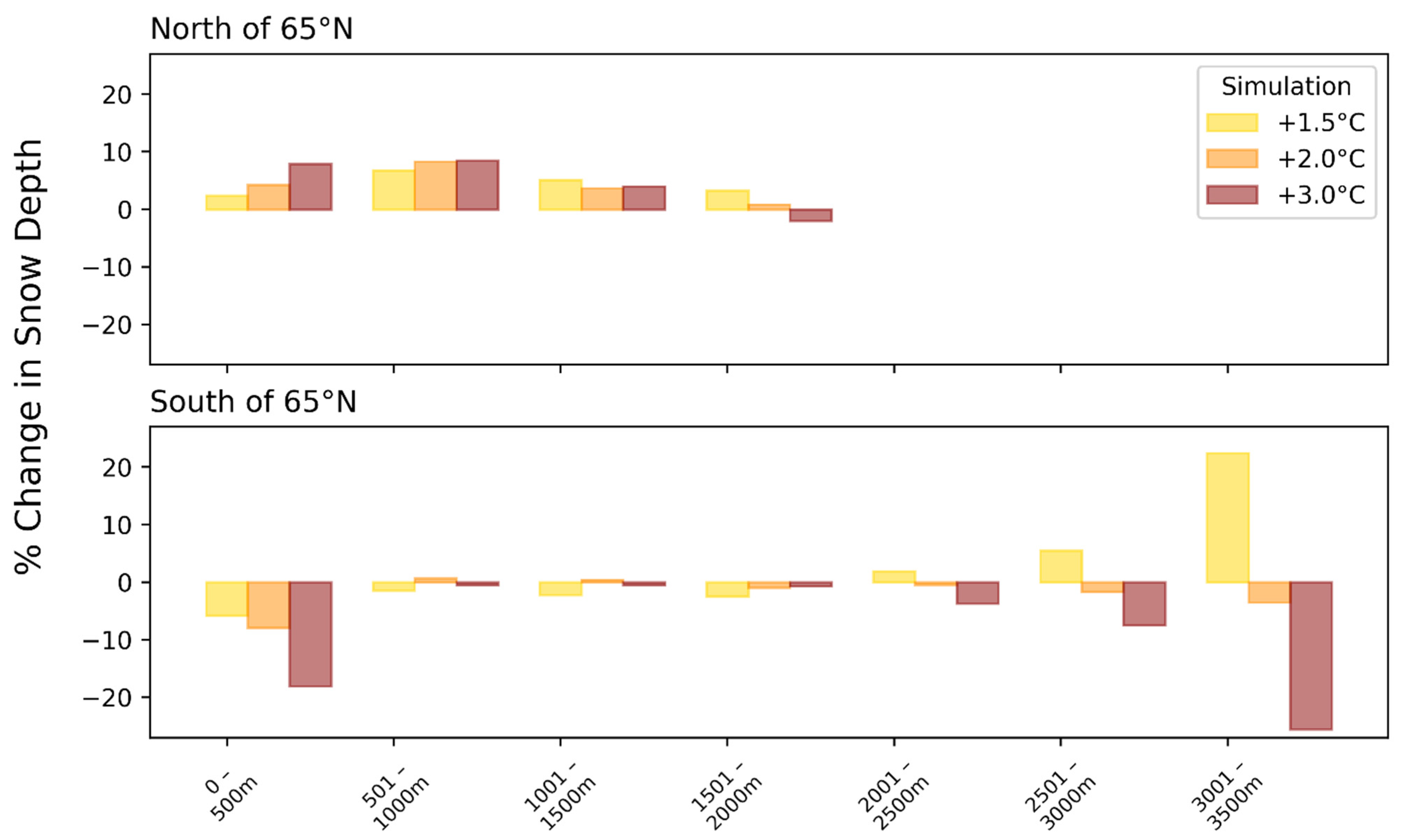
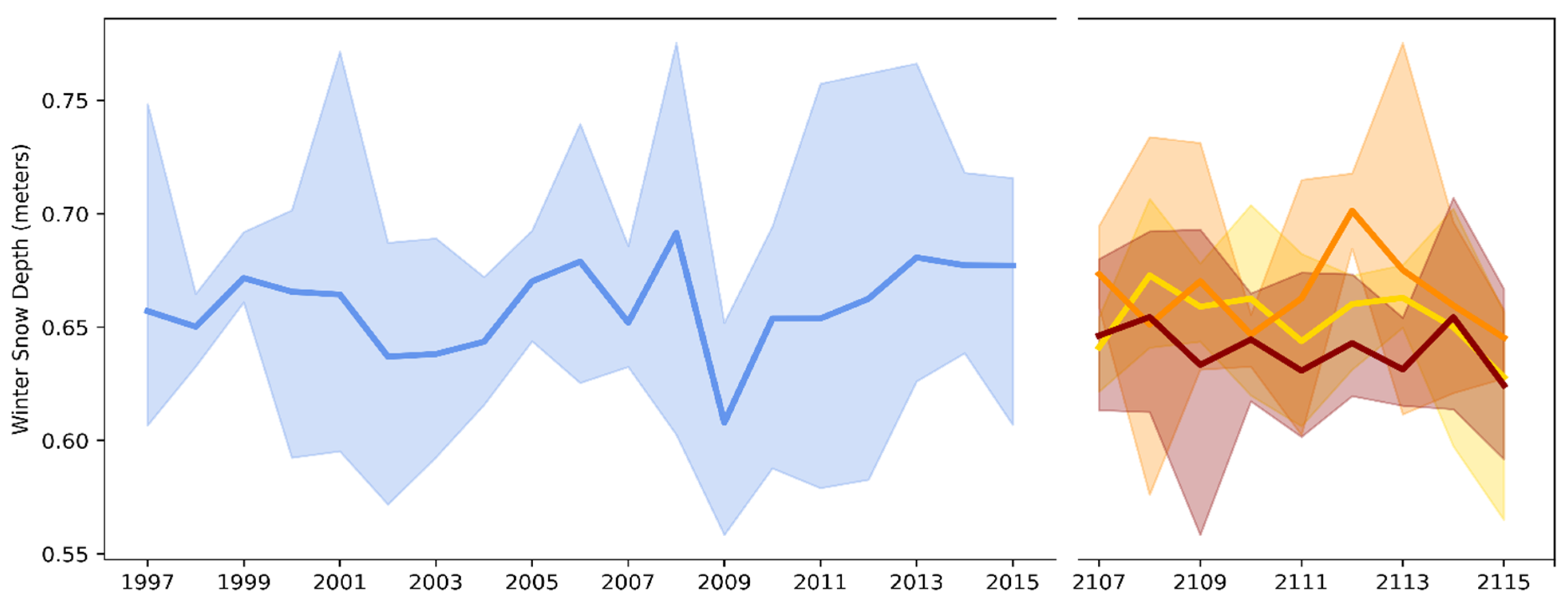
Publisher’s Note: MDPI stays neutral with regard to jurisdictional claims in published maps and institutional affiliations. |
© 2022 by the authors. Licensee MDPI, Basel, Switzerland. This article is an open access article distributed under the terms and conditions of the Creative Commons Attribution (CC BY) license (https://creativecommons.org/licenses/by/4.0/).
Share and Cite
Bigalke, S.; Walsh, J.E. Future Changes of Snow in Alaska and the Arctic under Stabilized Global Warming Scenarios. Atmosphere 2022, 13, 541. https://doi.org/10.3390/atmos13040541
Bigalke S, Walsh JE. Future Changes of Snow in Alaska and the Arctic under Stabilized Global Warming Scenarios. Atmosphere. 2022; 13(4):541. https://doi.org/10.3390/atmos13040541
Chicago/Turabian StyleBigalke, Siiri, and John E. Walsh. 2022. "Future Changes of Snow in Alaska and the Arctic under Stabilized Global Warming Scenarios" Atmosphere 13, no. 4: 541. https://doi.org/10.3390/atmos13040541
APA StyleBigalke, S., & Walsh, J. E. (2022). Future Changes of Snow in Alaska and the Arctic under Stabilized Global Warming Scenarios. Atmosphere, 13(4), 541. https://doi.org/10.3390/atmos13040541





